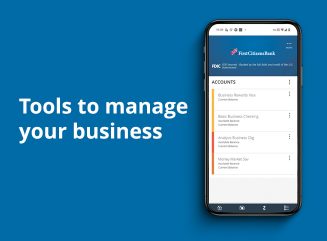Digital banking for business
Seamlessly access all of your accounts from one place with First Citizens Digital Banking for business.

Invest how you want, when you want, in real time with Self-Directed Investing.

Seamlessly access all of your accounts from one place with First Citizens Digital Banking for business.
We're committed to serving companies as they expand and succeed. The proof is in our success stories.
2026 Market Outlook video: Available now
The Making Sense team reflects on 2025 and discusses key headwinds and tailwinds for 2026.
Invoice factoring sometimes gets a bad rap—it can carry high fees, and the practices of factoring companies aren't always very transparent. But factoring does have some real advantages, especially in offering financing to firms that might otherwise have very few options due to their credit profile or growth stage.

Invoice factoring may provide a lifeline to manufacturing companies when used wisely and obtained from a reputable firm. It can also provide a strategic stepping stone to lower-interest bank financing.
Sometimes referred to as invoice discounting, factoring is a financing tool commonly used by small and medium-sized businesses, particularly in capital-intensive industries like manufacturing. To access immediate cash flow, you sell your account receivables, or A/Rs, to a factoring firm at a discount, typically 2% to 5%.
The factoring firm then follows up directly with your customers to obtain payment for the outstanding invoices. If your customers don't pay within 30 days, factoring firms will either levy an additional discount or return that invoice to you and recover the pre-payment, also called an advance, from the next allotment of A/Rs.
Factoring provides some definite advantages, most notably immediate cash flow. Manufacturers typically extend net 10 to 30-day credit terms to customers, depending on the customer's credit profile. The 30-day terms can be 45 actual days if you provide a delivery window. Although these terms help you build great customer relationships and sell product, they also reduce your cash flow. By factoring those receivables, you get cash now and not 45 days later.
Garnering your own credit terms with the raw material or pre-assembly suppliers, as well as obtaining a line of credit, can help greatly. However, not all manufacturers qualify. In addition, a lender may restrict the credit line's collateral to large corporate or government customer receivables, for example. Because factoring firms generally allow you to factor as many or as few of your outstanding receivables as needed, they can provide much-needed flexibility.
The costs associated with invoice factoring won't be a good fit for every company. That 2% to 5% discount for a 30-day term is roughly equivalent to a 24% to 60% annual interest rate. You'd only pay this much if your customers don't pay their invoices for an entire year, but at the end of the day, whether or not your clients pay is in their hands, not yours.
In addition, companies can rely too heavily on factoring to bridge cash flow gaps. This can become a treadmill with factoring eating up a significant portion of operational cash flow with high finance charges and discounts. Factoring 100% of receivables can significantly reduce margins. In the manufacturing industry where net profit margins are often less than 10%, overuse of factoring can lead to losses and financial distress.
Although invoice factoring can be expensive, it may have its place in a company's strategy. If you're considering this approach, factor some of your receivables, not all. Use the practice for newer clients who are credit-worthy but for whom your bank wants to see A/R aging over a few billing cycles. You might also use factoring to bridge the gap when your firm experiences rapid growth and a credit line increase lags a quarter or two. In these and similar scenarios, factoring can serve as a strategic alternative.
Invoice factoring is a short-term, periodic solution, not a long-term one. It can provide much-needed cash in high-growth scenarios. To ensure you use it wisely, identify how and when you'll use it in advance. Create a plan to move to cheaper funding sources as soon as you're able, then stick to that plan.



This material is for informational purposes only and is not intended to be an offer, specific investment strategy, recommendation or solicitation to purchase or sell any security or insurance product, and should not be construed as legal, tax or accounting advice. Please consult with your legal or tax advisor regarding the particular facts and circumstances of your situation prior to making any financial decision. While we believe that the information presented is from reliable sources, we do not represent, warrant or guarantee that it is accurate or complete.
Third parties mentioned are not affiliated with First-Citizens Bank & Trust Company.
Links to third-party websites may have a privacy policy different from First Citizens Bank and may provide less security than this website. First Citizens Bank and its affiliates are not responsible for the products, services and content on any third-party website.

Treasury & Cash Management
Electronic Bill Presentment & Payment
Investment & Retirement Services
Community Association Banking
Equipment Financing & Leasing
Credit Cards
Merchant Services
Email Us
Please select the option that best matches your needs.
Customers with account-related questions who aren't enrolled in Digital Banking or who would prefer to talk with someone can call us directly.